Richard A. Bermann: Tagebuch von der Saharafahrt 1933, Manuscript (1933)
Richard A. Bermann: Tagebuch von der Saharafahrt 1933, Manuscript (1933)
Gestern Abend im Hotel besah ich den kühnen Entdeckungsreisenden im Spiegel und fand die Rolle merkwürdig besetzt. Demnächst fünfzig Jahre alt, körperlich von jeher in zweifelhafter Verfassung, in diesem Jahre gar nicht in Form und mit allerlei Beschwerden, die ich vor mir geheim halte. Die Nerven seit den letzten Ereignissen in Deutschland beim Teufel; meine alte Elastizität dahin, von Optimismus keine Spur. Was mache ich also in den unentdeckten Teilen der Libyschen Wüste? Ich habe eine Antwort darauf: den Kopf in den Sand stecken.
[Yesterday evening at the hotel, I examined the intrepid explorer in the mirror and found the role strangely cast. Almost fifty years old, a physical constitution that has always been dubious, and certainly not fit this year, with all sorts of complaints that I keep secret from myself. Nerves all shot since the latest developments in Germany; my old resilience is gone, no sign of optimism. So what am I doing in these undiscovered parts of the Libyan desert? I know the answer: I‘m sticking my head in the sand. (ed. trans.)]
Extract from the first entry in Richard A. Bermann’s Tagebuch von der Saharafahrt 1933 [Sahara Expedition Diary 1933], from 4 March 1933, on board the Ausonia
In spring 1933, the writer and journalist Richard A. Bermann joined an expedition to the Libyan desert led by the aristocratic Hungarian adventurer and desert explorer, László Almásy. The expedition set out from Cairo on March 14, with the aim of locating and mapping the Zerzura Oasis. In addition to Bermann, the Berlin photographer Hans Casparius joined the expedition, as did, among others, the British flying ace, Hubert Penderel.
Initially, the expedition was a disappointment. A rival group was almost one day ahead of them. Moreover, it soon became clear that both Almásy and Penderel were using the expedition to add strategic information to their cartographic records for use in the imminent war. This led to tensions within the group. However, the travellers eventually stumbled across a series of magnificent cave paintings.
Richard A. Bermann documented the voyage in his diary. With an economical, often ironic and reserved style, he recorded both outward impressions and his inner mental state. The journal later formed the basis for his travel book Zarzura. Oase der kleinen Vögel [Zerzura. The Oasis of Small Birds], which was published in Zurich in 1938 and included many photographs taken by Hans Casparius.
Many decades later, the Canadian writer Michael Ondaatje used the story of the ‘Almásy-Penderel Expedition’ as the background for his novel The English Patient (1992), which was made into a hit film (1996). Bermann is immortalised in the novel in the form of the character who bears his name.
Further Reading:
Richard A. Bermann alias Arnold Höllriegel: Zarzura. Die Oase der kleinen Vögel. Die Geschichte einer Expedition in die Libysche Wüste. Hrsg. von Michael Farin und Andreas Stuhlmann. München: Belleville 2003




